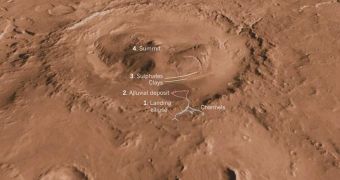The site that NASA finally selected for landing the Mars Science Laboratory (MSL) rover Curiosity in stands out from the rest of its former competitors through the fact that it boasts a massive, 5,000-meter-tall mountain in its center. Experts now say that the robotic explorer will attempt to climb it.
Naturally, the MSL could never get all the way up, but scientists plan to drive the machine as far up as possible. This should assist them in maximizing the scientific return of the entire mission. Curiosity would do well to pack some climbing gear, mission controllers joke.
Gale Crater is a 155-kilometer-wide depression on the surface of the Red Planet. The 5-kilometer mountain is located right at its center, and is believed to have been produced through erosion of sediments. It most likely took millions of years for this to happen.
After more than five years of deliberations, NASA experts and collaborators finally decided to send the rover to this crater. The decision was announced on July 22, and generated a lot of excitement among scientists in the international community.
“This might be the tallest mountain in the Solar System that we can climb with a rover,” John Grotzinger explains. He holds an appointment as a MSL project scientist, and is also a geologist at the California Institute of Technology (Caltech), in Pasadena.
“Gale is a geomorphologist's dream. But it has enough mineralogy to be interesting,” Arizona State University in Tempe researcher Phil Christensen explains. The MSL mission is managed by experts at the NASA Jet Propulsion Laboratory (JPL), also in Pasadena.
At this point, Curiosity is scheduled to remain on the surface of Mars for only two years. However, it is currently unclear whether that will actually be the case. If the Mars Exploration Rovers (MER) are any indication, we could expect the MSL to last for a lot longer.
Gale was considered a good choice for the MER mission too, back in 2003. At the time, NASA decided that it lacked the technological complexity to enable it to land a rover in that crater. Spirit and Opportunity were destined to drive only about 600 meters on Mars.
Opportunity odometer now shows more than 33 kilometers. The rover is in its seventh year of mission, and investigators are gathering important data from it. If Curiosity can endure for so long, then the amount of data it will collect from Gale Crater will far exceed that of the MER mission.
Curiosity is one of the first NASA missions in which the final decision on where to land the rover belongs to scientists. Engineers usually have the last saying, as they can determine whether a place is safe to land or not, Nature reports

 14 DAY TRIAL //
14 DAY TRIAL //